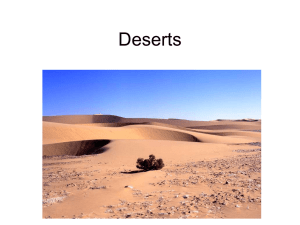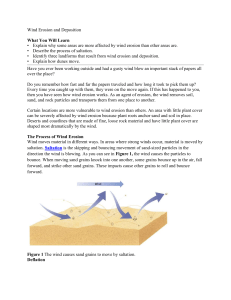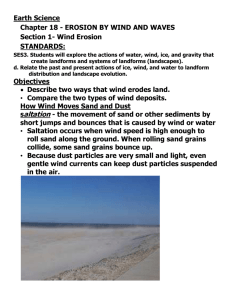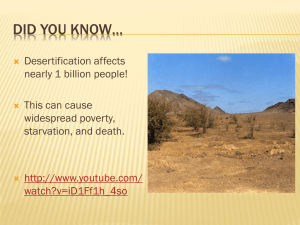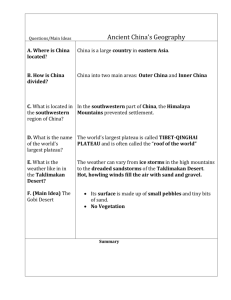Elemental Geosystems, 5e - Cal State LA
advertisement
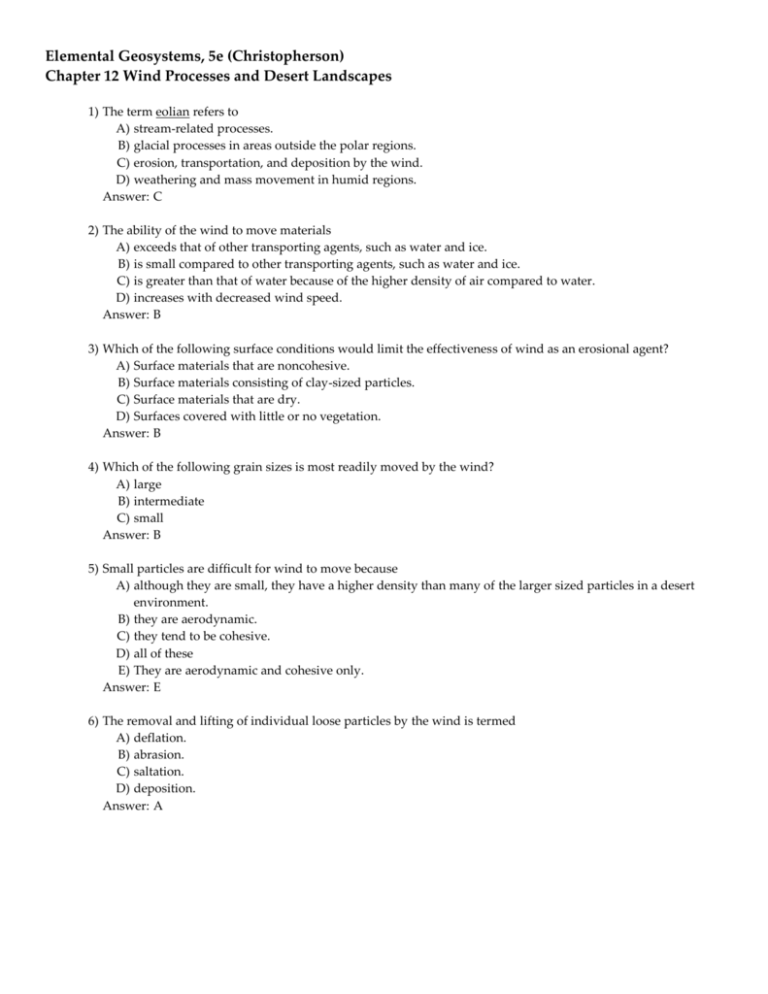
Elemental Geosystems, 5e (Christopherson) Chapter 12 Wind Processes and Desert Landscapes 1) The term eolian refers to A) stream-related processes. B) glacial processes in areas outside the polar regions. C) erosion, transportation, and deposition by the wind. D) weathering and mass movement in humid regions. Answer: C 2) The ability of the wind to move materials A) exceeds that of other transporting agents, such as water and ice. B) is small compared to other transporting agents, such as water and ice. C) is greater than that of water because of the higher density of air compared to water. D) increases with decreased wind speed. Answer: B 3) Which of the following surface conditions would limit the effectiveness of wind as an erosional agent? A) Surface materials that are noncohesive. B) Surface materials consisting of clay-sized particles. C) Surface materials that are dry. D) Surfaces covered with little or no vegetation. Answer: B 4) Which of the following grain sizes is most readily moved by the wind? A) large B) intermediate C) small Answer: B 5) Small particles are difficult for wind to move because A) although they are small, they have a higher density than many of the larger sized particles in a desert environment. B) they are aerodynamic. C) they tend to be cohesive. D) all of these E) They are aerodynamic and cohesive only. Answer: E 6) The removal and lifting of individual loose particles by the wind is termed A) deflation. B) abrasion. C) saltation. D) deposition. Answer: A 7) Desert pavement refers to A) specially constructed roadbeds in dry and hot regions. B) surfaces of concentrated pebbles and gravels that are produced by particle removal and waterdelivered cementing materials. C) surfaces that evidently were not affected by the 1991 Persian Gulf War. D) sand-covered surfaces. Answer: B 8) A desert pavement surface is associated with which of the following types of deserts? A) erg B) sand sea C) reg D) polar desert Answer: C 9) The sandblasting action of wind-blown particles is called A) deflation. B) abrasion. C) saltation. D) grinding. Answer: B 10) The lowering of the land surface by the lifting and removal of material is termed ________, whereas the grinding of rock surfaces with a "sandblasting" action is ________. A) abrasion; deflation B) deflation; abrasion C) saltation; abrasion D) mass wasting; deflation Answer: B 11) Which of the following can result from ORV (off road vehicle) use in a desert environment? A) It can cause destruction of vegetation through both direct and indirect effects. B) It can lead to a reduction in small animal populations. C) It can initiate erosion. D) All of the above can occur. E) None of the above ORV's have never been shown to cause measurable impacts on desert environments. Answer: D 12) Weathering that occurs by water in the desert is associated primarily with A) groundwater. B) field water capacity. C) hygroscopic water. Answer: C 13) A depression created by deflation is known as a A) playa. B) bolson. C) blowout depression. D) structural basin. Answer: C 14) Abrasion is usually confined to a zone that extends up to ________ above the ground. A) 1 cm (0.39 in) B) 1 m (3.28 ft) C) 5 m (16.4 ft) D) 10 m (32.4 ft) Answer: B 15) Rocks that appear pitted and grooved, and sometimes polished smooth by eolian processes, are termed A) ventifacts. B) yardangs. C) desert pavements. D) alluvium. Answer: A 16) Elongated, streamlined ridges aligned parallel to the most effective wind direction are called A) ventifacts. B) yardangs. C) desert pavements. D) alluvial rock structures. Answer: B 17) What size material composes the dust in a dust storm that extends thousands of feet above the ground? A) sand B) silts and clays C) gravels D) sand, silts, and clays Answer: B 18) The impact of saltating particles acts to A) initiate the movement of other particles. B) suppress the movement of other particles. C) abrade surfaces. D) both A and C E) both B and C Answer: D 19) Pebbles can be moved by ________ in a process known as ________. A) deflation; saltation B) deflation; surface creep C) saltating particles; deflation D) saltating particles; surface creep Answer: D 20) The skipping and bouncing action of saltation accounts for A) hydraulic lifting by air movements. B) the transport of very small grains, smaller than 0.01 mm in diameter. C) about 80 percent of wind transported particles. D) little or no surface creep. Answer: C 21) Which of the following is true of eolian ripples? A) They are generally positioned parallel with the direction of the effective wind. B) Their spacing is controlled by the moisture content of the sand. C) They are oriented transversely, or at right angles, to the direction of the wind. D) They form reg deserts made up of lag gravels. Answer: C 22) Active sand dunes and sandy deserts cover approximately what percentage of continental land between 30° N and 30° S latitude? A) 10 percent B) 50 percent C) 70 percent D) 90 percent Answer: A 23) An extensive area of sand and sand dunes is known as a/n A) reg desert. B) erg desert, or sand sea. C) lag desert. D) desert pavement. Answer: B 24) Desert sand is usually composed of what mineral? A) gypsum B) quartz C) dolomite D) calcite Answer: B 25) As deltas are depositional features of fluvial processes, so ________ are depositional features of eolian (wind) processes. A) canyons B) landslides C) moraines D) dunes Answer: D 26) Which side of a dune typically has a slope angle equal to that of the angle of repose for sand? A) windward B) leeward C) stoss D) top Answer: B 27) Relative to dune movement and form, a dune's slipface forms on which side? A) leeward side B) windward side C) freedune side D) none of these Answer: A 28) The steepest side of a dune has a maximum angle of about A) 5 degrees. B) 10 degrees. C) 34 degrees. D) 65 degrees. Answer: C 29) Which of the following dune types is incorrectly matched with the conditions necessary for its formation? A) barchan abundant sand B) transverse abundant sand C) parabolic vegetation controlled D) crescentic unidirectional wind Answer: A 30) Linear dunes and seif dunes are oriented A) parallel to the wind. B) perpendicular to the wind. C) randomly in relation to wind direction. Answer: B 31) A common crescent-shaped dune with horns pointed downwind is called a A) transverse dune. B) longitudinal dune. C) seif dune. D) barchan dune. Answer: D 32) A crescent-shaped dune with anchoring vegetation is called a A) barchanoid ridge. B) longitudinal dune. C) parabolic dune. D) reversing dune. Answer: C 33) A dune that is the mountainous giant of the sandy deserts is called a A) transverse dune. B) longitudinal dune. C) parabolic dune. D) star dune. Answer: D 34) Which of the following is not true of loess? A) It consists of fine-grained clays and silts and can form vertical cliffs. B) It serves as good agricultural land. C) It is derived from glacial outwash plains or deserts. D) It has low binding strength. Answer: D 35) Significant loess deposits are found in the A) Mississippi and Missouri valleys. B) eastern Washington region. C) Ukraine in the former Soviet Union. D) Loess Plateau of China, some 300,000 km2 (115,800 mi2). E) All of these regions contain loess. Answer: E 36) Dry, arid climates occupy approximately what percentage of Earth's land surface? A) 5 percent B) 10 percent C) 26 percent, and as much as 35 percent if all semiarid climates are considered D) 65 percent Answer: C 37) The spatial distribution of Earth's dry regions are attributable to all of the following factors except A) subtropical high-pressure cells between 15° and 35° N and S latitudes. B) rain shadows to the lee of mountain ranges. C) the equatorial low-pressure region and the ITCZ. D) great distances from moisture-bearing air masses. Answer: C 38) Desert landscapes tend to be ________ in appearance because of the ________. A) rugged and hard-edged; lack of water erosion B) rugged and hard edged; type of resistant rock found in deserts C) rounded and smooth; abrasion D) rounded and smooth; type of nonresistant rock found in deserts Answer: A 39) A desert is an area in which A) actual and potential evapotranspiration rates are roughly equal. B) actual evapotranspiration rates exceed potential evapotranspiration rates. C) potential evapotranspiration rates exceed actual evapotranspiration rates. D) hot conditions exist throughout the year. Answer: C 40) Which of the following correctly describes a dry stream bed that is intermittently filled with water? A) wash B) wadi C) arroyo D) all of these Answer: D 41) On the desert floor, at locally low elevations, an intermittently wet-and-dry flat area in a region of closed (interior) drainage is called a A) wash. B) wadi. C) playa. D) arroyo. Answer: C 42) A characteristic cone-shaped depositional feature in the desert that usually forms at the mouth of a canyon is known as a/n A) bajada. B) playa. C) bolson. D) alluvial fan. Answer: D 43) Which of the following is not true of alluvial fans? A) They often serve as good sources of groundwater. B) They frequently occur in the eastern U.S. C) The largest sized sediment is found near the top of the fan, and the smallest near the bottom. D) They are depositional features. Answer: B 44) If several alluvial fans merge together, a ________ is formed. A) pediment B) bajada C) playa D) yardang Answer: B 45) Buttes, mesas, and inselbergs represent A) pinnacles of rock and rock masses that were uplifted by compressional forces. B) erosional remnants of a once extensive and continuous rock layer. C) erosional remnants of vertically tilted strata. D) the erosional remnants of volcanoes (i.e., volcanic necks). Answer: B 46) Cross-stratification can be used by geologists to A) locate water. B) determine paleo-wind directions. C) find ventifacts. D) locate fault planes. Answer: B 47) Which of the following can be found in the Basin and Range province? A) horsts and grabens B) faults C) alluvial fans D) pediments E) all of these Answer: E 48) The Basin and Range Province was formed by A) faulting. B) tensional forces resulting from the fact that North America overrode a subducted ocean plate and was raised and stretched in the process. C) compressional forces resulting from the collision of North America with a microplate, and which resulted in the creation of a folded mountain belt. D) both A and B E) both A and C Answer: D 49) Which of the following is true? A) Playas are located in bolsons. B) Bolsons are located in playas. C) Bolsons and playas are geographically separate landforms that bear no topographic relationship to one another. Answer: A 50) The major erosional force in the desert is A) wind. B) the eolian process. C) water and fluvial processes. D) human activity. Answer: C 51) An exotic stream is A) any river that flows from an arid region to one of adequate precipitation. B) one involved in a particular historical event. C) one whose entire course is in a desert region. D) any river that arises in a humid region and then passes through to an arid region. Answer: D 52) Addition of more dams on the Colorado River would result in ________ available water because ________. A) more; of the obvious fact that dams create reservoirs, which store water that would otherwise flow into the sea B) less; some of the impounded water would seep into rock and become unavailable C) less; some of the water would evaporate D) both B and C Answer: D 53) Which of the following is true regarding the Colorado River? A) Average flows today are roughly the same as when the Colorado River Compact was signed. B) John Wesley Powell was a strong advocate for the current policy of river management. C) Each party to the Colorado River Compact is entitled to an absolute amount of water, measured in millions of acre feet. D) California has used only its alloted share of water form the Colorado River. Answer: C 54) Which is not true of the issues surrounding the use of Colorado River water? A) The 1999-2005 drought is more severe than any seen in the historical record. B) Lakes Powell and Mead are at 38-54% of capacity. C) It would take 13 winters with normal snow pack to "reset" the Colorado River system. D) Arizona's population grew 36% from 1990-2000, while Las Vegas grew 540% from 1985-2005. E) Recent efforts have focused exclusively on reducing demand for water. Answer: E 55) Which of the following characterizations regarding Colorado River discharges and annual budgets is correct? A) There are adequate average flows (1930-1980) in the system to meet the Compact (1923) and Mexican Water Treaty (1944) allotments. B) The reservoirs that are in operation experience insignificant losses of water due to rock storage and evaporation. C) The average flows in the second half of this century are more than double the budgeted amount. D) The river system is about 3.5 million acre-feet in deficit from meeting annual budgets based on average flows from 1930 to 1980. Answer: D 56) Desertification is caused by A) poor agricultural practices. B) deforestation. C) global climate change. D) all of these Answer: D 57) Desertification is not caused by which of the following? A) overgrazing B) climate change C) erosion and salinization of crop land D) deforestation E) all of the above cause desertification Answer: E 58) The wind has relatively minor effects on weathering and erosion. Answer: True False 59) Water is essential to the formation of a desert pavement. Answer: True False 60) Gibber plain, erg, and sand sea are regional names for the same type of desert surface. Answer: True False 61) The Persian Gulf War resulted in the disruption and destruction of thousands of square kilometers of desert pavement. Answer: True False 62) A ventifact can be used to determine the dominant wind direction in an area. Answer: True False 63) The dust in a dust storm consists primarily of wind-blown sand. Answer: True False 64) Saltation accounts for the majority of material transported by the wind. Answer: True False 65) Most of Earth's desert lands are covered by the familiar sand seas. Answer: True False 66) Barchan, transverse, and parabolic dunes are all types of crescentic sand dunes. Answer: True False 67) Active and stable sand regions occur on every major continent except Antarctica. Answer: True False 68) Soils formed from loess tend to be infertile. Answer: True False 69) Loess deposits occur worldwide on every major continent other than Antarctica. Answer: True False 70) Principal arid and semiarid lands only occur on the continental landmasses of the Northern Hemisphere. Answer: True False 71) Alluvial fans often serve as groundwater sources. Answer: True False 72) The amount of Colorado River water allocated to various states was based on an overestimate of the typical average annual discharge; consequently, there is not enough water available to meet the allocation requirements. Answer: True False 73) Much of desertification is due to human actions. Answer: True False



